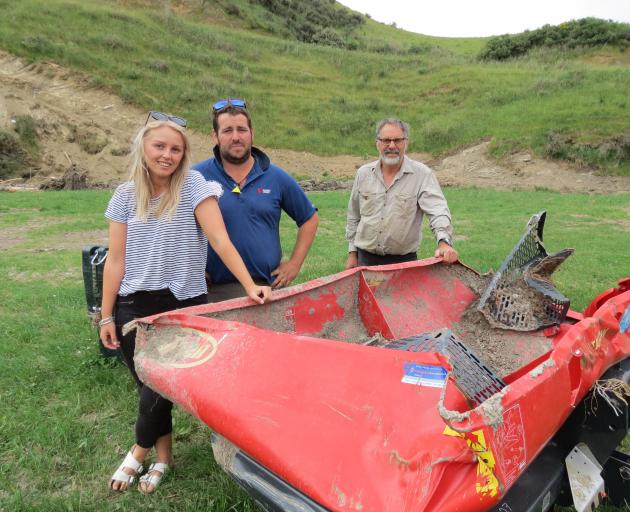
The same intense storm on Sunday, November 26 that caused flooding, evacuations and infrastructure damage in Roxburgh also caused major flooding to farms above Millers Flat.
Farm owner Chris Pemberton, partner Jaimee Coulter, and his parents, Rod and Paddy-Ann Pemberton, were shocked when the storm caused a flash flood that swept down a small creek, breaking its banks, and flooding a shed and land below the homestead.
Rod said the flood caused Phantom Creek, usually a small ''single stride'' creek that ran through their 500ha property on Tima Burn Rd, to burst its banks, turning it into a 100m wide torrent.
Chris said the water had built up further up the creek behind a blockage, and then when that burst, a ''wall of water'' thundered towards them.
He and Ms Coulter had ridden a side-by-side bike to try to get the tractor out of the way of the water. The creek was so deep and strong, the quad floated for a time before gaining traction, giving them both a fright.
Ironically, Ms Coulter said they had been out water skiing earlier that day.
Their shed and smoko room was left with water and silt up to the benches, and they lost equipment and workshop tools, while fences were destroyed.
Paddocks were left covered in massive boulders, debris and silt, and 36ha of their 45ha of fodder beet crop was wiped out or damaged by hail.
However, no stock was lost, nor was anyone injured, although the lost crops were uninsured.
''It was some of the best crops we have had before it flooded,'' Chris said.
''It was just about jumping out the ground.''
Rod said they had resown about 24ha of the fodder beet at a cost of about $30,000.
''Other crops were flattened but look like perking up.''
He said it was getting close to the end of the planting season and one paddock was left unable to be resown because of the water damage.
''We may well suffer [in the winter] because of the reduced crop yield.''
A one tonne bag of grass seed had floated away, while a tractor's dual-wheel was found 8km downstream. Their tractor, although damaged when it was submerged, was being repaired.
Other equipment was found on neighbours' properties or would have to be replaced as the floodwater damaged the electronics.
''A fertiliser spreader was found in a ravine miles away and had to be retrieved by a helicopter,'' Chris said.
The day after the flood, about 16 Young Farmers members, neighbours, family and friends arrived to help with the cleaning up and another four Young Farmers put in a day's fencing last week.
''We very much appreciate it,'' Rod said.
The huge pile of logs that washed up below the house would eventually make good firewood, Chris said.
Neighbouring farmers the Macdougall family lost two stock bridges and some fences in addition to other damage.
Others had water in their homes or were threatened by it, including Quince bed and breakfast.
Teviot Rd had been damaged but was passable by the Monday morning.
Peter McDougall said despite the storm, the district was so dry the area was right on ''tipping point''.
''What we need is a good steady rain across the district or we will have a serious drought,'' Mr McDougall said.
-By Yvonne O'Hara
Comments
The damage from this, or these, storms really seems to be caused by landslips damming the creeks, then the dams bursting. I only have the media reports to go on, but all of these rocks didn't just float off the hillsides.
That would indicate that it is an erosion problem, and that would indicate that the land is being overgrazed, making it susceptible to erosion.
We need to see what is happening further upstream but that doesn't seem to be shown in the media. While this happened in a storm, I am left wondering if farming practices are not the most probable cause for this unusual result, and I would like to see more coverage showing what is happening on the land further up these streams in order to resolve this matter.
